CCB Extract Parameters and Bucket Configuration
This page provides information about the configurations required for the Oracle Utilities Customer Care and Billing (CCB) application to enable successful data extracts for Oracle Utilities Extractors and Schema.
Note: You must complete these setups before starting the ELT processes to load data into Oracle Utilities Analytics Warehouse.
On this page:
Customer Analytics Configuration Page
The extract parameters and bucket configurations for Oracle Utilities Customer Care and Billing (CCB) application are to be made on the Customer Analytics Configuration page. To access it, log in to the source configuration and select Customer Analytics Configuration from Admin menu.

The Customer Analytics Configuration page for CCB is divided into two sections that will be described below: Customer Analytics Configuration Details and Bucket Configuration List. It also has a link to navigate to the Master Configuration page.
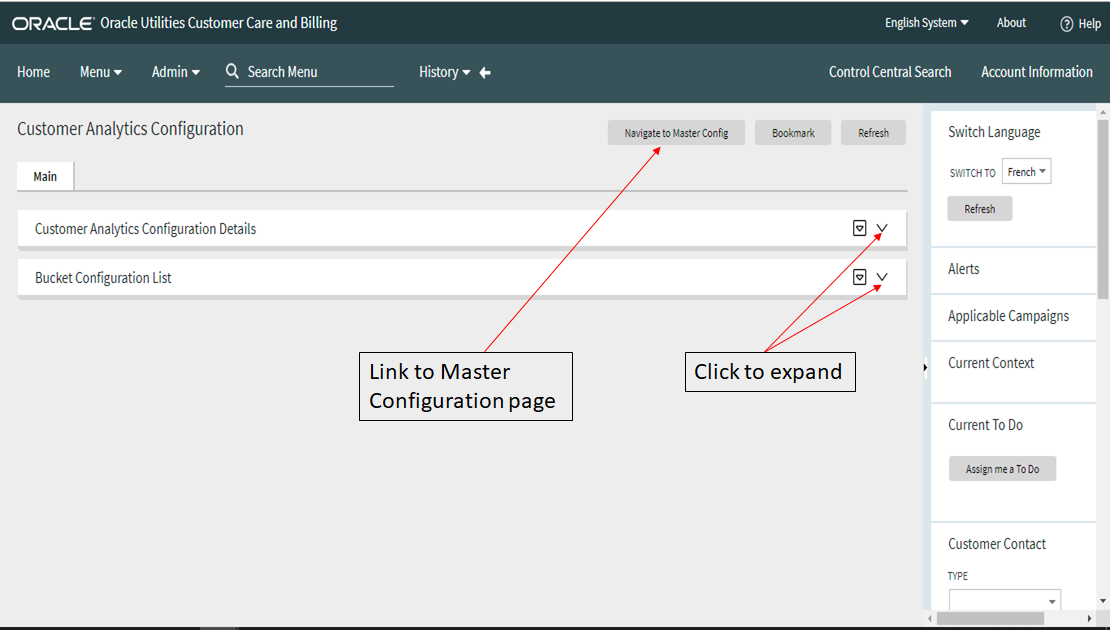
Customer Analytics Configuration Details
On the Customer Analytics Configuration Details section, you will find the list of the master configuration business objects (BOs) that were created for Oracle Utilities Extractors and Schema, as well as the extract parameters required for the ELT loads.
The parameters that have already been set up will have a foreign key link to the parameter type's parent page, and those that have not been set up yet will only have the parameter name header column.
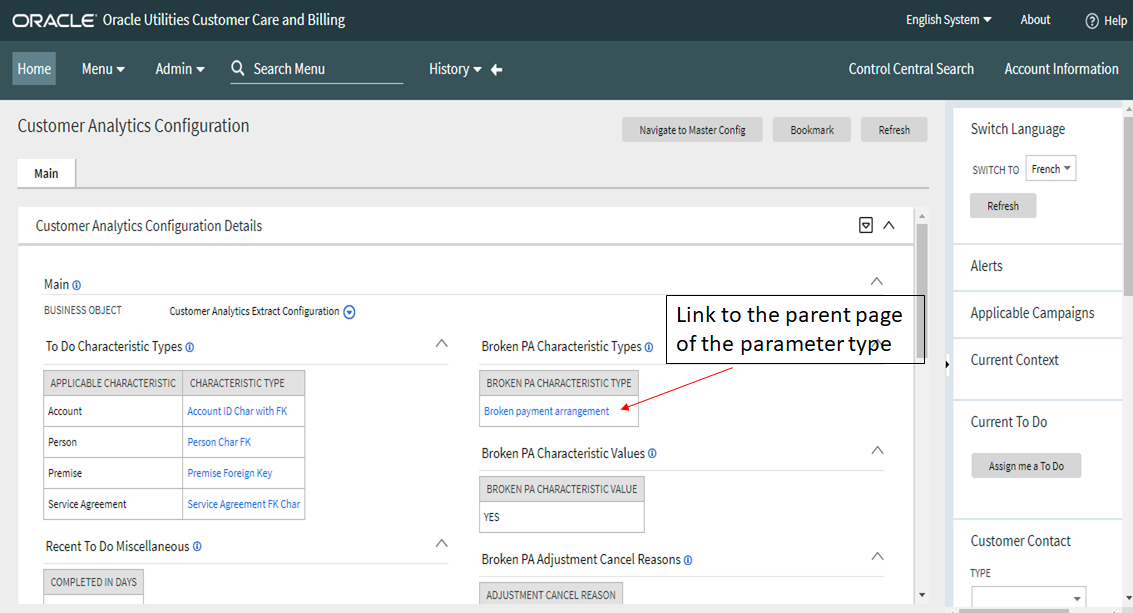
Extract Parameters
During extraction of source data to BI data warehouse, there are certain parameters that need to be configured by implementation to identify or filter data in accordance with business requirements. Once these parameters have been set up by the end user, the ELT process can then use these information to selectively extract data or to transform it from the source application and populate it into the warehouse. The BI Extract Parameters Configuration BO is delivered to contain the list of parameter values that need to be configured to be used by the ELT process.
To Do Characteristic Types Parameter
This single-valued extract parameter is used by the To Do facts (CF_TD_ENTRY and CF_RECENT_TD_ENTRY) to configure the Account, Service Agreement, Person, and Premise characteristic types that are used to determine the corresponding entities related to a To Do.
To set the parameter value:
- Navigate to the To Do Characteristic Types parameter on the Customer Analytics Extract Configuration page.
-
Select an option from the Applicable Characteristic drop-down menu.
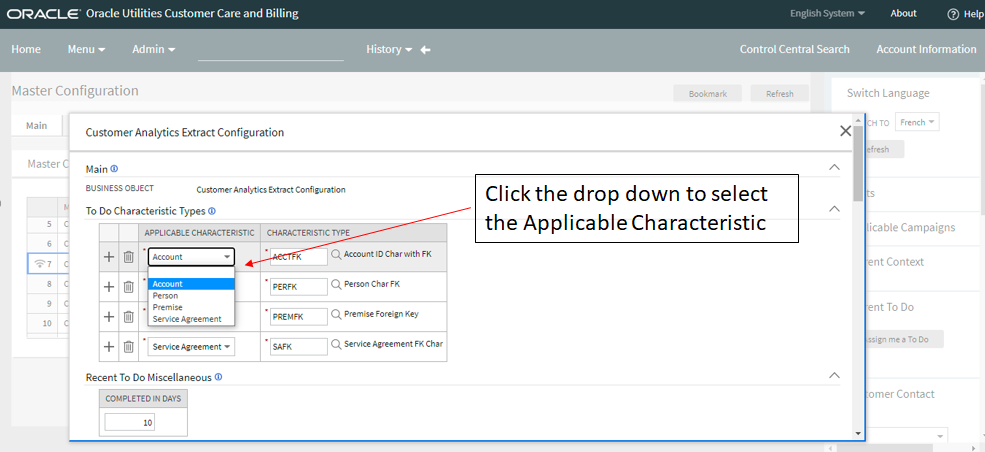
-
Click on the search icon to open the characteristic entities list and select a Characteristic Type. Click Save.

- Follow the same steps to set the rest of the values.
Recent To Do Miscellaneous Parameter
This single-valued extract parameter is used to configure a numeric value that denotes the Completed in Days parameter. Recent To Do entry fact loads all active and completed To Do entries done within a configured range of days.
To set the parameter value:
- Navigate to the Recent To Do Miscellaneous parameter on the Customer Analytics Extract Configuration page.
- Provide a numeric value in the text entry box and click Save.
Financial Transaction Characteristic Types Parameter
This multi-valued extract parameter holds the Revenue and Tax characteristic values that are used by the Financial Transaction (CF_FT), Financial Transaction General Ledger (CF_FT_GL), and SA Billing (CF_SA_BILLING) facts to determine the revenue and tax amounts of the FT.
To set the parameter value:
- Navigate to the Financial Transaction Characteristic Types parameter on the Customer Analytics Extract Configuration page.
- Select the Applicable Characteristic from the drop-down menu.
- Click on the search icon to open the characteristic entities list and select a Characteristic Type. Click Save.
- To add more values, click the (+) icon and populate the required fields.
Financial Transaction Characteristic Value Parameter
This multi-valued extract parameter contains the GL Account characteristic types that are used to determine the GL Accounts that are extracted for the Financial Transaction (CF_FT), Financial Transaction General Ledger (CF_FT_GL), and SA Billing (CF_SA_BILLING) facts.
To set a parameter value:
- Navigate to the Financial Transaction Characteristic Values parameter on the Customer Analytics Extract Configuration page.
- Select an option from the Applicable Attribute drop-down menu.
- Populate the Characteristic Value text field and click Save.
- To add more values, click the (+) icon and populate the required fields.
Exclude Archive Adjustment Types Parameter
This multi-valued extract parameter contains all the archive adjustment types that should be excluded by the FT (CF_FT) and FT GL (CF_FT_GL) facts.
To set the parameter value:
- Navigate to the Exclude Archive Adjustment Types parameter on the Customer Analytics Extract Configuration page, and click the search icon to open the Adjustment Type window.
-
On the Adjustment Type window, provide the adjustment type or the description value and select the appropriate adjustment type from the list of results. Click Save.

- To add more types, click the (+) icon and populate the required fields.
Broken PA Characteristic Types Parameter
This single-valued extract parameter is used by the Payment Arrangement facts (CF_PA and CF_PA_SNAP) and contains the Broken characteristic type that is used to identify if a payment arrangement is broken.
To set the parameter value:
- Navigate to the Broken PA Characteristic Types parameter on the Customer Analytics Extract Configuration page, and click the search icon to open the Characteristic Type window.
- On the Characteristic Type window, provide the characteristic type or the description value and select the appropriate characteristic type from the list of results. Click Save.
Broken PA Characteristic Value Parameter
This single-valued extract parameter is used by the Payment Arrangement facts (CF_PA and CF_PA_SNAP) and contains the Broken characteristic value that is used to identify if a payment arrangement is broken.
To set this parameter value:
- Navigate to the Broken PA Characteristic Values parameter on the Customer Analytics Extract Configuration page.
- Select the appropriate characteristic value from the drop-down menu.
- Click Save.
Broken PA Adjustment Cancel Reasons Parameter
This single-valued extract parameter is used by the Payment Arrangement facts (CF_PA and CF_PA_SNAP) and contains the adjustment cancel reason that is used to identify if a payment arrangement is broken.
To set this parameter value:
- Navigate to the Broken PA Adjustment Cancel Reasons parameter on the Customer Analytics Extract Configuration page.
- Select a value from the Adjustment Cancel Reason drop-down menu.
- Click Save.
Overdue Bill Characteristic Types Parameter
This multi-valued extract parameter is used by the Overdue Process (CF_COLL_PROC) and the Event (CF_COLL_EVT) extracts and contains the overdue bill characteristic type that is used to identify the bill that is associated with the Overdue Process.
To set the parameter value:
- Navigate to the Overdue Bill Characteristic Types parameter on the Customer Analytics Extract Configuration page.
- Select a value from the Applicable Characteristic drop-down menu and click the search icon on the Characteristic Type column to open the Characteristic Type window.
- On the Characteristic Type window, provide the characteristic type or the description value and select the appropriate characteristic type from the list of results. Click Save.
- To add more types, click the (+) icon and populate the required fields.
High Bill Complaint Characteristic Types Parameter
This multi-valued extract parameter is used by the SA Billing fact (CF_SA_BILLING) and contains the characteristic type that is used to identify the bill associated with the High Bill Complaint case.
To set this parameter value:
- Navigate to the High Bill Complaint Characteristic Types parameter on the Customer Analytics Extract Configuration page.
- Select a value from the Applicable Characteristic drop-down menu and click the search icon on the Characteristic Type column to open the Characteristic Type window.
- On the Characteristic Type window, provide the characteristic type or the description value and select the appropriate characteristic type from the list of results. Click Save.
- To add more types, click the (+) icon and populate the required fields.
High Bill Complaint Case Types Parameter
This multi-valued extract parameter is used by the SA Billing fact (CF_SA_BILLING) and contains the case types for high bill complaint cases.
To set this parameter value:
- Navigate to the High Bill Complaint Types parameter on the Customer Analytics Extract Configuration page.
- Select the appropriate Case Type value from the drop-down menu and click Save.
- To add more Case Type values, click the (+) icon and populate the required fields.
Exclude High Bill Complaint Case Statuses Parameter
This multi-valued extract parameter is used by the SA Billing (CF_SA_BILLING) fact to determine if a bill is associated to a high bill complaint and contains the case statuses for which High Bill Complaint cases should not be considered. If this parameter is configured then all these statuses will not be excluded at the time of populating high bill indicator.
To set this parameter value:
- Navigate to the Exclude High Bill Complaint Case States parameter on the Customer Analytics Extract Configuration page.
- Select a value from the Case Status drop-down menu and click Save.
- To add more Case Types, click the (+) icon and select a value from the drop-down menu.
- To add more Case Statuses, click the (+) icon and select the appropriate values.
SA Snapshot Miscellaneous Parameter
This single-valued extract parameter contains a numeric value to denote the Exclude SAs Closed in Days parameter. Exclude SAs Closed in Days, if specified, is used to retrieve SAs closed within the last x days and to include them on the SA Snapshot (CF_SA) and Payment Arrangement Snapshot (CF_PA_SNAP) facts.
To set this parameter value:
- Navigate to the SA Snapshot Miscellaneous parameter on the Customer Analytics Extract Configuration page.
- Populate the text field with a numeric value.
- Click Save.
Include Bill Calculation Lines Parameter
This single-valued extract parameter contains a value for bill segment lines to be included. It is used to calculate CALC_AMT column in Billed Usage fact (CF_BILLED_USAGE).
To set this parameter value:
- Navigate to the Include Bill Calculation Lines parameter on the Customer Analytics Extract Configuration page.
- Select a value from the Include Bill Calculation Lines drop-down menu.
- Click Save.
Bucket Configuration List
The Bucket Configuration List zone provides an overview of which bucket configurations have been set up so far and which are yet to be set up.
On this zone you will find the Business Objects and Bucket Types configured for the buckets. Under the Bucket Configuration column, the buckets that have already been set up will have a foreign key reference link to the Bucket Configuration Maintenance portal, which allows you to view or edit the current bucket values. Buckets that have not been configured will have an Add (+) button in the Add column.
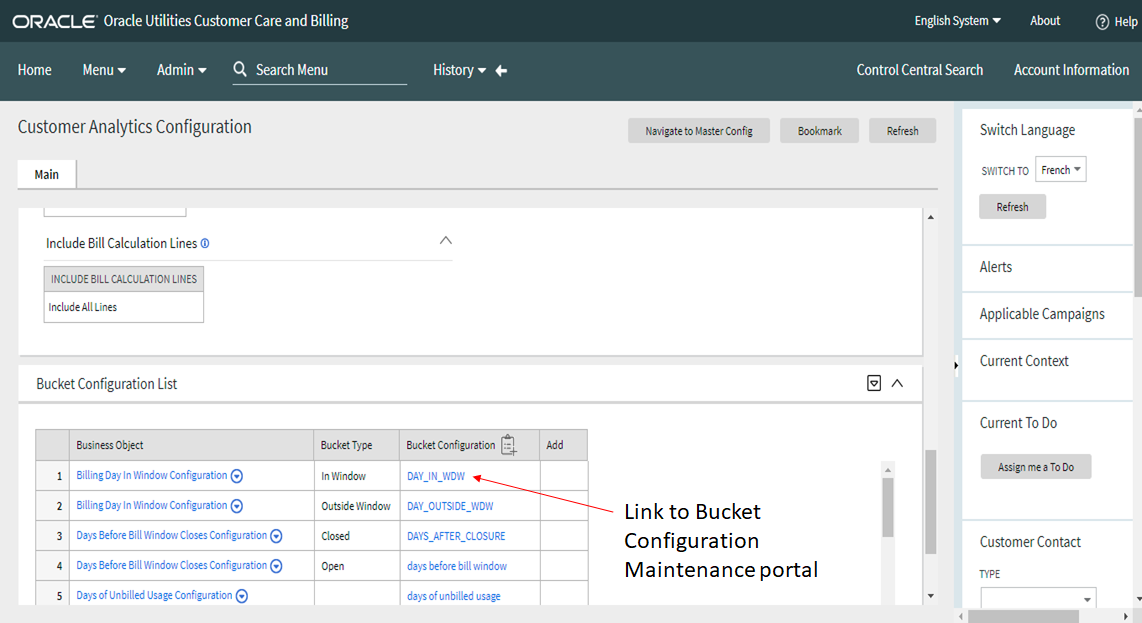
Oracle Utilities Analytics Warehouse (OUAW) allows you to define a set of ranges, each representing a bucket, for which extracted measures can be grouped and classified. This allows the user to get reports with groups of data in accordance with a particular classification or bucket. These configurations can be made from the Analytics Configuration portal in the CCB application.
Billing Day In Window Buckets
This configuration defines the bucket ranges that identify the day on which the bill segment got frozen within the billing window. It also indicates whether the range is within or outside the window. Two sets of ranges can be defined for this bucket configuration: one set for day ranges that fall inside the billing window (In Window status), and another set for day ranges that fall outside the billing window (Outside Window status). This bucket configuration data is extracted into the Billing Day In Window dimension (CD_BILL_DAY_IN_WIN) and referenced in the SA Billing fact (CF_SA_BILLING).
No values are delivered as a part of the base product. Here are some sample values:
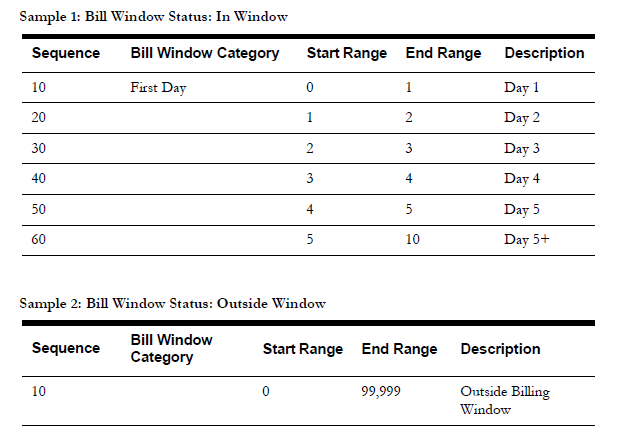
The following rules are enforced for these buckets:
- Only one set of ranges can be defined for each bill window status (In Window and Outside Window).
- No gaps or overlaps are allowed within the bucket ranges for a bill window status.
- One initial bucket is required (bucket range starts at 0).
- One catch-all bucket is required for the bucket configuration with the bill window status of Outside Window (bucket end range with maximum value of 99999).
- One and only one bucket range should be categorized as First Day for the bucket configuration with the bill window status of In Window.
To add this bucket to the configuration list or to add new bucket ranges, follow the steps on Configure CCB Buckets.
Days Before Bill Window Closes Buckets
This configuration defines the bucket ranges that identify the number of days left before the bill window closes. Two sets of ranges can be configured for this bucket configuration: one set for day ranges when the bill window is still open (Open status), and another set for days when the bill window is closed (Closed status). This bucket configuration data is extracted into the Days Before Bill Window Closes dimension (CD_DAYS_TO_WIN_CLS) and referenced in the SA Billing fact (CF_SA_BILLING) to determine the number of days left for correcting bill segments in Error state before the bill window closes.
No values are delivered as a part of the base product. Here are some sample values:
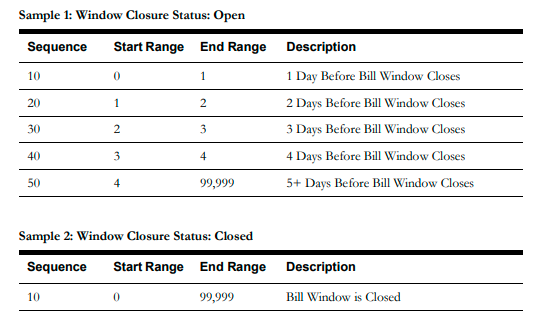
The following rules are enforced for these buckets:
- Only one set of bucket configuration can be defined for each window closure status (Open and Closed).
- No gaps or overlaps are allowed within the bucket ranges of a window closure status.
- One bucket should have 0 as its start range.
- Only one range is allowed for the closed window status and it has to catch all the measures (end range has the maximum value of 99999).
To add this bucket to the configuration list or to add new bucket ranges, follow the steps on Configure CCB Buckets.
Days of Unbilled Usage Buckets
This configuration defines the bucket ranges used to identify how many days of unbilled usage a service agreement has. The data is extracted into the Days of Unbilled Usage dimension (CD_DAYS_UNBILLED_USG) and is referenced in the SA Arrears Snapshot fact (CF_ARREARS).
No values are delivered as a part of the base product. Here are some sample values:

The following rules are enforced for these buckets:
- Only one set of the days of unbilled usage bucket configuration is allowed.
- No gaps or overlaps are allowed within the bucket ranges.
- Only one catch-all bucket is allowed and required (the bucket end range has the maximum value of 99999).
- Only one initial bucket is allowed and required (bucket range that starts at 0).
To add this bucket to the configuration list or to add new bucket ranges, follow the steps on Configure CCB Buckets.
Days Since Last Frozen Bill Segment Buckets
This configuration defines the bucket ranges used to identify the number of days past since a bill segment of the service agreement got frozen. This bucket configuration data is extracted into the Days Since Last Frozen Bill Segment dimension (CD_DAYS_LAST_FRZ_BS) and is referenced in the SA Arrears Snapshot fact (CF_ARREARS).
No values are delivered as a part of the base product. Here are some sample values:
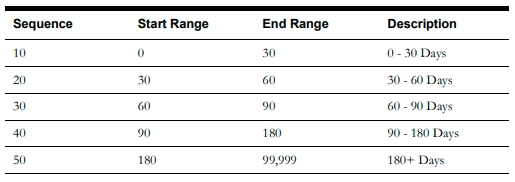
The following rules are enforced for these buckets:
- Only one set of the days since last frozen bill segment bucket configuration is allowed.
- No gaps or overlaps are allowed within the bucket ranges.
- One and only one catch-all bucket is allowed and required (the bucket end range has the maximum value of 99999).
- One and only one initial bucket is allowed and required (bucket range starts at 0).
To add this bucket to the configuration list or to add new bucket ranges, follow the steps on Configure CCB Buckets.
PA Future Payment Age Buckets
This configuration uses day ranges to define the age of scheduled payments (where "age" refers to the number of days within which a payment is supposed to be made) for payment arrangements. The future payments for a payment arrangement are approximated using the number of installments left and the frequency that the payment arrangement SA is billed (via the bill cycle schedule of the account). This bucket configuration data is used in PA Accumulation (CF_PA) and Snapshot (CF_PA_SNAP) facts.
No values are delivered as a part of the base product. Here are some sample values:

The following rules are enforced for these buckets:
- Only one set of future payment age bucket configuration is allowed.
- No gaps or overlaps are allowed within the bucket ranges.
- One bucket should have the start range as 0
- One and only one catch-all bucket is allowed and required (bucket end range has maximum value of 99999).
To add this bucket to the configuration list or to add new bucket ranges, follow the steps on Configure CCB Buckets.
PA Number of Installments Buckets
This configuration defines the bucket ranges used to group payment arrangements based on the number of installments. This bucket configuration data is extracted into the Number of Installments dimension (CD_INSTALLMENT_CNT) and is referenced in the PA Accumulation (CF_PA) and the Snapshot (CF_PA_SNAP) facts.
No values are delivered as a part of the base product. Here are some sample values:

The following rules are enforced for these buckets:
- Only one set of number of installment bucket configuration is allowed.
- No gaps or overlaps are allowed within the bucket ranges.
- One and only one catch-all bucket is allowed and required (bucket end range has maximum value of 99999).
- One and only one initial bucket is allowed and required (bucket range starts at 0).
To add this bucket to the configuration list or to add new bucket ranges, follow the steps on Configure CCB Buckets.
PA Recurring Charge Amount Buckets
This configuration defines the bucket ranges used to group payment arrangements based on their recurring charge amounts. This bucket configuration data is extracted into the PA Recurring Charge Amount dimension (CD_REC_CHARGE_AMOUNT) and is referenced in the PA Accumulation/Snapshot fact (CF_PA/CF_PA_SNAP).
No values are delivered as a part of the base product. Here are some sample values:
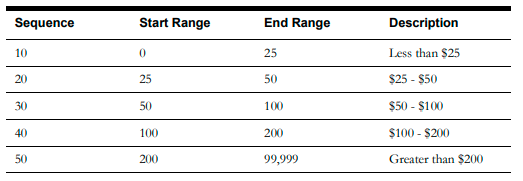
The following rules are enforced for these buckets:
- Only one set of recurring charge amount bucket configuration is allowed.
- No gaps or overlaps are allowed within the bucket ranges.
- One and only one catch-all bucket is allowed and required (bucket end range with maximum value of 99999).
- One and only initial bucket is allowed and required (bucket range starts at 0).
To add this bucket to the configuration list or to add new bucket ranges, follow the steps on Configure CCB Buckets.
PP Future Payment Age Buckets
This configuration defines the age buckets for which future payments for pay plans are scheduled to be paid. This bucket configuration data is used in Pay Plan Accumulation (CF_PAY_PLAN) and Snapshot (CF_PAY_PLAN_SNAP) facts to categorize a payment plan's future payments into one of these buckets.
No values are delivered as a part of the base product. Here are some sample values:

The following rules are enforced for these buckets:
- Only one set of future payment age bucket configuration is allowed.
- No gaps or overlaps are allowed within the bucket ranges.
- One and only one catch-all bucket is allowed and required (bucket end range has maximum value of 99999).
To add this bucket to the configuration list or to add new bucket ranges, follow the steps on Configure CCB Buckets.
SA Arrears Buckets
This configuration defines the bucket ranges for the service agreement's arrears age. This bucket configuration data is used in the SA Arrears Snapshot fact (CF_ARREARS).
No values are delivered as a part of the base product. Here are some sample values:
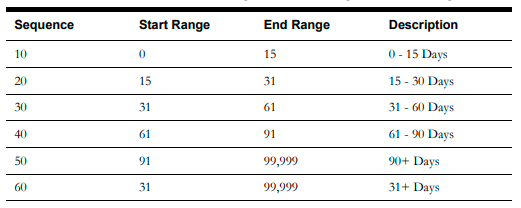
The following rules are enforced for these buckets:
- Only one set of arrears age bucket configuration is allowed.
- At least one catch-all bucket has to be defined (bucket end range has maximum value of 99999).
- Gaps in bucket ranges are not allowed.
- Overlaps are allowed within the bucket ranges.
To add this bucket to the configuration list or to add new bucket ranges, follow the steps on Configure CCB Buckets.